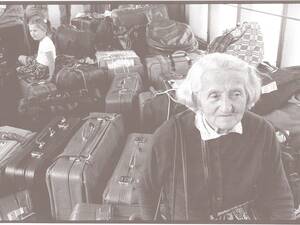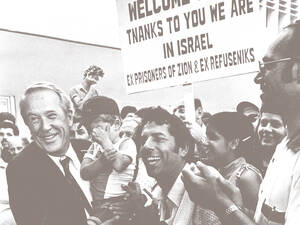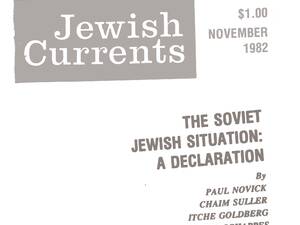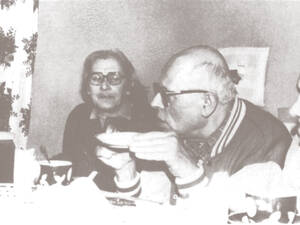The Best Place in the World for Soviet Jews
The Soviet Jewry Movement exposed a rift between Israel and the US that persists to this day.

Russian immigrants disembark in Israel, 1990.
In 1970, 14 young Soviet Jews and two non-Jewish friends unsuccessfully tried to hijack a Soviet commercial plane from the Leningrad airport, intending to fly to Sweden and ultimately make their way to Israel. At the very least, the group’s leaders wanted to bring international attention to their demand for free emigration for all Soviet Jews to the Holy Land. Up until that point, the USSR had accepted visa applications only from Jews who could prove they had family members in Israel, and even then denied many of those applicants permission to leave, thereby creating a community of Jews seeking to emigrate; the most ideologically committed and organized among them came to be known as “refuseniks.” The would-be Leningrad hijackers indeed made international headlines when they were arrested on the airport tarmac and then harshly sentenced at a show trial. A worldwide uproar following the verdicts pushed the Kremlin to convene a retrial, leading to commuted death sentences and reduced prison terms. Shortly thereafter, Soviet authorities significantly eased emigration restrictions, sparking a sharp rise in the numbers of Jews applying for and receiving exit visas to Israel.
One might expect that this global spectacle of Jews fighting to emigrate to Israel—or “make aliyah,” in Zionist parlance—would have had great resonance in Israel itself. To some extent this was true. Tensions between Israel and the Soviet Union had been on the rise since the Six-Day War three years earlier, when Moscow had armed Israel’s attackers, severed diplomatic ties with the country, and launched a fierce anti-Zionist propaganda campaign throughout the Eastern bloc. Not surprisingly, then, many Israelis celebrated the Leningrad hijackers’ desperate attempt to leave Russia for Israel as a Zionist call to arms, and tens of thousands filled Israel’s streets in support. Demonstrators’ demands on their own government for increased action on behalf of Soviet Jews led Israel to establish the semi-official Public Council for Soviet Jewry.
In the larger scheme of things, however, this surge of Israeli public mobilization around the cause of Soviet Jewry turned out to be an exception rather than the rule. Many older Ashkenazis remained ambivalent about the Soviet Union because of longstanding ideological and cultural allegiances as well as lasting gratitude stemming from the USSR’s support for Israel’s independence in 1948. After the Leningrad trials, while diaspora activists were doubling down on the cause of Soviet Jewry, most Israelis withdrew from sustained engagement in the campaign and—if public opinion polls from the time can be trusted—did not support assertive action from their government. The weight of seemingly endless domestic crises and aftershocks from the 1973 Yom Kippur War pushed the Soviet Jewry campaign to the background for the vast majority of Israelis, leaving advocacy confined to pockets of former refuseniks and concerned intellectuals who agitated from within the country’s universities, health system, labor unions, and youth movements.
These realities fly in the face of the traditional Israeli narrative about the country’s role in the global Soviet Jewry movement, a story in which the Jewish state served as the movement’s international headquarters. Based on this version of events, Israeli officials believed that a primary umbrella agency for the movement in North America, the National Council for Soviet Jewry, “was essentially our creation,” as the Israeli diplomat Yoram Dinstein put it in a later interview. Convinced by such testimonies, historians would claim—as the scholars Peter Hagel and Pauline Peretz wrote in a paper—that “Israel provided the impetus for the transnational mobilization on behalf of Soviet Jewry.” According to some accounts, diaspora Jewish communities were initially too timid to lobby their governments on behalf of Soviet Jews who wished to leave the USSR. This changed (so the story goes) only when Israel, an inspiration and protector for Jews everywhere since 1948, used shrewd diplomacy and a semi-secret government agency known as Nativ or Lishkat Hakesher to kindle advocacy movements around the world, which Jerusalem orchestrated thereafter.
Israel’s leaders were wary of getting pulled into Cold War jousting, and in the state’s first two decades, did not openly encourage Soviet Jewish emigration.
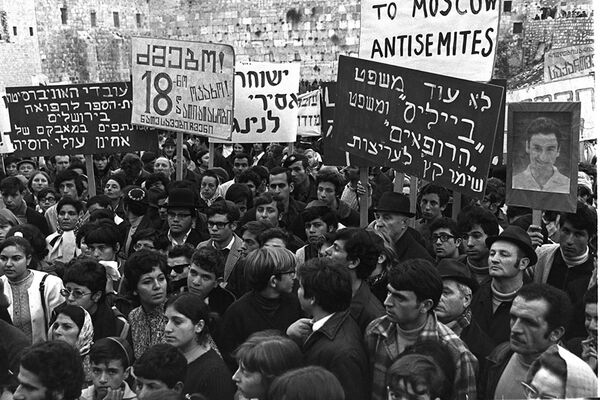
Youth movement members demonstrate in City Hall Square in Tel Aviv, ca. 1970.
Viewed with a historian’s eye, however, Israel’s place in the global Soviet Jewry movement is more ambiguous. Israel’s leaders were wary of getting pulled into Cold War jousting, and in the state’s first two decades, did not openly encourage Soviet Jewish emigration. Beginning in the early 1950s, they cultivated contacts with Jews behind the Iron Curtain and encouraged action in the diaspora through Nativ. But its limited personnel inside the USSR, and Soviet Jewish reticence about being observed meeting with foreigners, meant that Nativ reached only small numbers of Soviet Jews, just a fraction of whom wanted to emigrate to Israel. On the other side of the Atlantic, Nativ often found itself at odds with homegrown advocacy groups in the diaspora that did not appreciate Nativ agents’ demands for authority over the direction of their campaigns. By the end of the 1970s, the grassroots organizations had soured on Nativ’s heavy-handed intervention. Only in the late 1980s, under pressure from immigrant leaders like Natan Sharansky (a formerly incarcerated refusenik, or “Prisoner of Zion,” who became a vocal advocate for Soviet Jewry shortly after his arrival in Israel) and advocacy groups like the emigrant-led Magen and Ma’oz organizations, did the government pursue more visible action.
Ultimately, Israel supported Soviet Jewry in ways that it saw as aligning with its own national interests. On the one hand, Israel’s government wished to avoid conflict with both Moscow and Washington and therefore preferred passive support for emigration. On the other, the country’s leaders insisted that all emigrants who did leave the USSR should arrive on Israel’s own shores—a move they hoped would bolster the country’s Jewish population and reinforce the Zionist principle that Israel should be the destination for Jews everywhere. Their adamance on this point ignited tensions between Israel and many Jewish leaders in the diaspora that reverberate today when prominent Israeli officials respond to antisemitic incidents in Europe and the Americas with the suggestion that meaningful and safe Jewish lives are possible solely in the Jewish state.
In the early 1970s, US Congress members began debating the Jackson-Vanik and Stevenson amendments, provisions to the 1974 Trade Act that linked US foreign trade policy in dealings with communist countries (or “nonmarket economies,” in the formal language of the amendments) to these countries’ human rights records and emigration policies. The amendments stipulated that Soviet access to US computer technology, grain, and the coveted “Most Favored Nations” status that conferred favorable commercial and credit terms, would be conditioned on the Kremlin’s enacting emigration policies allowing Jews and other national minorities to freely leave the USSR. American Jewish advocacy groups threw their weight behind the amendments, which diaspora activists saw as the apex of their efforts to support Soviet Jewish emigration.
In Israel, however, responses to the Jackson-Vanik and Stevenson amendments were very different. Officials there hedged in public statements but quietly aligned themselves with the Nixon administration, which opposed the amendments out of concerns that they would threaten the stability of the Cold War détente the White House had negotiated with the Brezhnev administration. Israeli leaders had no desire to jeopardize their country’s special relationship with the United States, on which they relied for military and diplomatic support, by coming into conflict with the Nixon administration. Some Israeli officials also believed that the amendments might backfire if they caused the Soviets to reimpose stricter emigration rules. Indeed, fear of reprisal had long shaped Israel’s preference for quiet diplomacy when dealing with the Soviet Jewry issue. The furthest any Israeli leader had ever gone before that was in 1969, when Prime Minister Golda Meir called on the USSR from the Knesset podium to permit large-scale aliyah. While surely an emotional moment, the statement proved mostly symbolic in light of the fact that Meir’s declaration did not substantially alter Israel’s future actions.
Strains between Israel and some American Jewish organizations around the amendments turned out to be only a prelude. The next act, a drama surrounding the so-called “dropout” crisis, quickly followed. In 1974, thousands of emigrants en route to Tel Aviv via Vienna began demanding the right to migrate to North America or western Europe, even though their exit from Russia had been contingent on emigration to Israel. Some “dropouts” preferred the West because of Israel’s well-publicized housing shortages; others did not want to resettle in a conflict zone or simply desired a more cosmopolitan society. Within two years, half of all Soviet Jewish emigrants refused transit to Israel. Some absorption centers in the country had closed by 1976 because so many would-be emigrants had dropped out in Europe.
Israeli leaders saw the growth of its Soviet Jewish population as a boon, and considered these defections a disaster. They feared the increase of the Palestinian population inside the Green Line and in the newly conquered occupied territories, and hoped that a large influx of Soviet Jews would help ensure a Jewish majority between the Mediterranean Sea and the Jordan River. Israeli politicians and bodies like the Public Council for Soviet Jewry and the Jewish Agency also saw Soviet emigration as a Zionist project in ideological terms, arguing that emigration to Israel offered the best chance for secularized Soviet Jews to strengthen their ethnoreligious identity. Finally, Soviet Jewish immigrants—many of whom had worked in the USSR’s advanced industries and elite research institutions in fields like dentistry and mechanical engineering and astronomy—promised an economic boost. In 1970, hoping to expand the pool of possible emigrants from the USSR, the Knesset amended national immigration policy. Israel’s Law of Return had since 1950 awarded citizenship to any Jew with a Jewish mother, effective immediately upon arrival to the country. The 1970 revision expanded the law to include emigrants with a Jewish grandparent or to spouses of anyone who qualified for citizenship. This policy adjustment aimed to include many potential Soviet olim (emigrants) who had non-Jewish parents or had married non-Jews.

New immigrants with gas masks in the absorption room at Ben-Gurion International Airport, February 1991.
The dropout crisis quickly generated conflict between the Israeli government and many diaspora activists in the Soviet Jewry movement. Some diaspora leaders, like Ralph Goldman, CEO of the Joint Distribution Committee (JDC), agreed with the Israeli assessment that it was the best destination for Soviet Jews. But even those who shared this view generally supported freedom of choice for “dropouts” and worked to enable absorption in North America for emigrants who desired it. The JDC and the Hebrew Immigrant Aid Society (HIAS), for instance, campaigned in Washington for Soviet Jews to be recognized as refugees, thereby circumventing normal US immigration quotas. These efforts infuriated Israeli leaders, leading to the bizarre spectacle of Israel using quasi-diplomatic channels to lobby the American Jewish establishment to help restrict emigration options for Soviet Jews. Prime Minister Yitzhak Rabin, for example, mobilized Max Fisher, a Nixon confidant, to negotiate a compromise with organizations like the JDC and HIAS. (Under Fisher’s stillborn proposal, the American organizations would cease aiding dropouts in Vienna, and Soviet Jews who sought migration to the West—and aid from the JDC and HIAS—would be required to apply for exit visas at the appropriate foreign embassies in Moscow.) The question of coercive aliyah became controversial within Israel, too, with prominent figures and groups like the veteran politician and diplomat Abba Eban and the Ha’aretz editorial board condemning it.
The crisis forced diaspora organizations to choose between fealty to Israel and a moral obligation—fed in great part by memories still fresh from the Holocaust era—to help refugees. The organizations’ dilemma deflated only in 1981, when the Kremlin made the question moot by choking off emigration for its own reasons. While wretched for anyone desiring to leave the USSR, this closure of the gates of emigration may have saved Israel–diaspora relations from going over the edge.
Debate over the importance of Israel’s role in the Soviet Jewry movement constitutes a layer in lingering frictions with diaspora Jewry around who should determine the direction of global Jewish life.
About 125,000 Soviet emigrants eventually made aliyah during the 1970s. Among these, only a few thousand were active refuseniks whose desire to freely practice Judaism made them poster children for the idea that Soviet Jews would find their one true home in Israel. The high rate of dropouts who never made it to Israel underscored the fact that refuseniks did not represent the totality, or perhaps even a plurality, of Soviet Jews. Recent scholarship, together with assessments from some diaspora activists, suggests that most Soviet Jews of the time were satisfied with their lives and had benefited no less than their non-Jewish neighbors from Soviet policies. Relative to the size of the community in the USSR, few Jews prioritized emigration until the Soviet system descended into chaos in the late 1980s. Even then, hundreds of thousands elected not to emigrate to Israel when other opportunities arose, instead choosing calmer lives in North America and Germany.
Debate over the importance of Israel’s role in the Soviet Jewry movement constitutes a layer in lingering frictions with diaspora Jewry around who should determine the direction of global Jewish life. North American Jews’ priorities never matched Israel’s; both sought greater freedom for their Soviet brethren, but they disagreed on what constituted freedom, who had the power to decide, and where Russian-speaking Jews should fit into the future Jewish world. Looking at the period with historical evidence in hand, we can conclude that—contrary to narratives promoted by former Israeli officials and some of their activist partners in the US—the campaign in support of the Soviet Jewry movement was not a monolithic operation run from Jerusalem, but a global movement, with multiple centers. Weighing its successes more soberly can help us to understand an origin point for power struggles between Israel and diaspora activists that has only become more pronounced in the decades that followed.
Jonathan Dekel-Chen is Rabbi Edward Sandrow Chair in Soviet & East European Jewry at the Hebrew University of Jerusalem. His research deals with modern Jewish history, transnational philanthropy and advocacy, non-state diplomacy, agrarian history, and migration.


